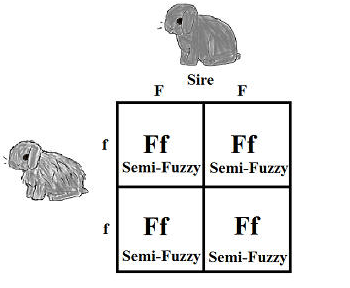lesson 4: gene interactions
Key words:
-Codominance
-Incomplete dominance
-Epistasis
-Pleiotropy
So in previous pages, we've learned that a dominant allele masks a recessive allele, right? This is true in most cases, except where codominance or incomplete dominance involved.
Codominance is when the two different alleles in a hybrid blend together, and the resultant phenotype is halfway between the two. For example, an imaginary red gene and yellow gene blend, making the offspring orange.
Incomplete dominance is when the alleles are both expressed. For example, an imaginary blue gene and white gene combine, causing the offspring to be blue with white spots.
Here's an example of codominance. The wool, or, fuzzy gene is recessive, denoted by f. A rabbit with two of the fuzzy genes, ff, has wool fur. If a rabbit has two dominant, FF genes, then it has normal fur. A rabbit with Ff genotype has normal fur, but slightly longer and thicker.
They say a picture (or Punnett Square) is worth a thousand words, so here's an example for you:
-Codominance
-Incomplete dominance
-Epistasis
-Pleiotropy
So in previous pages, we've learned that a dominant allele masks a recessive allele, right? This is true in most cases, except where codominance or incomplete dominance involved.
Codominance is when the two different alleles in a hybrid blend together, and the resultant phenotype is halfway between the two. For example, an imaginary red gene and yellow gene blend, making the offspring orange.
Incomplete dominance is when the alleles are both expressed. For example, an imaginary blue gene and white gene combine, causing the offspring to be blue with white spots.
Here's an example of codominance. The wool, or, fuzzy gene is recessive, denoted by f. A rabbit with two of the fuzzy genes, ff, has wool fur. If a rabbit has two dominant, FF genes, then it has normal fur. A rabbit with Ff genotype has normal fur, but slightly longer and thicker.
They say a picture (or Punnett Square) is worth a thousand words, so here's an example for you:
All of the offspring would be Ff (fuzzy carrier), and be semi-fuzzy (slightly longer than normal) in phenotype.
Next let's talk about epistasis. Epistasis sounds like a terrifying word, but it's really quite simple. Basically, an epistatic gene is one that is able to mask another gene. The other gene is still there but is not expressed. A great example of this is the REW (ruby-eyed white) gene. It is recessive, denoted by cc. When a rabbit carries the REW gene (Cc), the REW gene is not expressed. However, when a rabbit is homozygous recessive cc, this masks ALL the other color genes. So the rabbit may genetically be a chestnut, a blue, a pointed white, a broken orange, or any other color UNDERNEATH the REW gene, but that color is not expressed because the REW gene has 'blocked' it.
Pleiotropy is when one gene results in multiple, seemingly unrelated effects. There aren't really any good examples of this in rabbits, but a great example is the frizzle gene in chickens. When a chicken inherits this gene, it makes the feathers curly rather than flat. However, it also results in larger organs, a faster metabolism, and sometimes even infertility. So although it seems like just a feather gene, it really affects so much more! It's definitely one of the most interesting phenomena of genetics.
That's it for now! Hopefully this has given you a better grasp on basic genetics to better understand my other articles. :)
Next let's talk about epistasis. Epistasis sounds like a terrifying word, but it's really quite simple. Basically, an epistatic gene is one that is able to mask another gene. The other gene is still there but is not expressed. A great example of this is the REW (ruby-eyed white) gene. It is recessive, denoted by cc. When a rabbit carries the REW gene (Cc), the REW gene is not expressed. However, when a rabbit is homozygous recessive cc, this masks ALL the other color genes. So the rabbit may genetically be a chestnut, a blue, a pointed white, a broken orange, or any other color UNDERNEATH the REW gene, but that color is not expressed because the REW gene has 'blocked' it.
Pleiotropy is when one gene results in multiple, seemingly unrelated effects. There aren't really any good examples of this in rabbits, but a great example is the frizzle gene in chickens. When a chicken inherits this gene, it makes the feathers curly rather than flat. However, it also results in larger organs, a faster metabolism, and sometimes even infertility. So although it seems like just a feather gene, it really affects so much more! It's definitely one of the most interesting phenomena of genetics.
That's it for now! Hopefully this has given you a better grasp on basic genetics to better understand my other articles. :)
